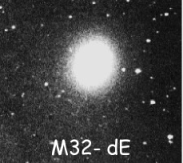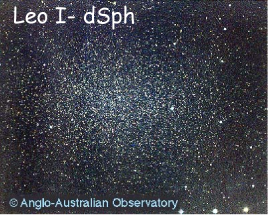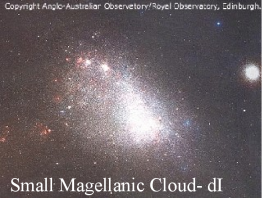Tidal dwarf galaxies
A dwarf galaxy is, as the name implies, a small galaxy. Dwarf galaxies tend to orbit larger galaxies. For example, scientists classify our nearby Large Magellanic Cloud (LMC) as a dwarf galaxy. By comparison, the Milky Way is estimated to have 200-400 billion stars and the LMC is composed of only several billion stars. Dwarf galaxies, like their larger counterparts, come in different classifications. Remember the three classifications of galaxies? (Spiral, elliptical and irregular). Not surprisingly, dwarf galaxies have similar morphologies:
(1) Dwarf elliptical galaxies (dE) and subtype dwarf spheroidal galaxies (dSph)
(2) Dwarf irregular galaxies (dI)
(3) Dwarf spiral galaxies and dwarf barred spiral galaxies. [Few papers refer to dwarf spirals, and there is some debate as to whether they really exist. Other scientists consider dwarf irregular galaxies to be the dwarf version of large spirals. We’re just going to focus our attention on dwarf ellipticals, spheroidals and irregulars.]
Although dwarf galaxies may look like mini versions of larger galaxies, they do have different properties. Dwarf ellipticals are similar to larger elliptical galaxies, but they are obviously much dimmer, (see M32). Dwarf spheroidal galaxies are also very dim. They tend to be gas poor and diffuse, (see Leo I). The last group, dwarf irregular galaxies, tend to be slightly brighter than dwarf spheroidals, possibly because they are areas of active star formation. The Small Magellanic Cloud (SMC) is a dwarf irregular galaxy that orbits the Milky Way. Its deformed shape is probably due to gravitational forces from the LMC and the Milky Way. Dwarf galaxies tend to be very metal-poor (Metals in astronomy refer to any elements after hydrogen on the periodic table. Therefore, 'metals' in astronomy can actually refer to elements such oxygen and carbon- or generally any element heavier than hydrogen.). Some display evidence that they have experienced more than one burst of star formation; others may have a nucleus (which is seen as a small central bulge). Finally, the mass-to-light ratio of dwarfs can be extremely large-- this means that they have a large amount of mass compared to the amount of light they emit.
THIS SECTION NEEDS AN EXPLANATION OF WHAT IS A TIDAL DWARF GALAXY
Literature Review (what we know so far)
The M81 galaxy group consists of several strongly interacting galaxies, including M81, M82, NGC 3077 and NGC 2976. (Appleton et al. 1981 and Boyce et al. 2001). Infrared imaging of the spiral arms and tidal tails of M81 has revealed numerous bright star-forming regions and significant amounts of cold dust (Gordon et al. 2004).
Gravitational interaction of galaxies has been shown to produce tidal neutral hydrogen (HI) tails, and these are particularly prominent in M81. In other words, there is a huge cloud of neutral hydrogen (HI) encompassing these interacting galaxies. [Neutral hydrogen or HI is a fancy astronomer way of saying Hydrogen that still has all of its electrons. If it loses an electron it is no longer neutral and it is called HII. The H stands for hydrogen (but I’m sure you already guessed that) and the I and II are Roman numerals. 'I' is short for neutral and 'II' is short for ionized once (lost one electron). Hydrogen only has one electron to lose, but other elements, such as Oxygen can lose more. So what happened to OIII? You guessed it, OIII is an Oxygen that is doubly ionized, or has lost 2 electrons.] The strong galactic interaction may account for the formation of tidal dwarf galaxies (TDGs). These TDGs would form from condensed Interstellar Medium (ISM) that was stripped from the main body of one of the interacting galaxies in the group. (Makarova 2002).
Many scientists cite the fact that M81, M82, NGC 3077, and NGC 2976 are embedded in a huge HI cloud with extended tidal HI bridges between them as evidence of past gravitational interaction. Furthermore, past surveys of the M81 area have shown that there are a large number of dwarf galaxy candidates in the M81 group (Borngen & Karachentseva 1982; Karachentseva et al. 1985; van Driel et al. 1998; Boyce et al. 2001; Karachentsev et al. 2001). Some of the areas in these HI bridges have been identified as dwarf galaxies. Karachentseva et al. (1985) suggests that those dwarf galaxies are actually tidally disrupted dwarfs. From these studies it seems fair for us to infer ("Infer" is not quite the same as conclude. Think of it as a temporary assumption that makes sense of our observations, but may not be what is actually occurring) that:
- M81 is in a group of gravitationally interacting galaxies,
- galactic interactions cause HI tidal regions,
- dwarf galaxies tend to form in these HI tails,
- gravitational interactions may stimulate star formation in tidal tails.
Arp's loop, another region within the interacting M81 complex, was found by Efremov et al. (1986) to have a lot of very faint blue stars and diffuse objects. Efremov suggested that there is ongoing star formation in the loop, stimulated by the interaction of M81 with M82 and NGC 3077. This is similar to the findings of Durrell et al. (2005), which found new regions of blue stars in the interstellar space between M81 and a nearby galaxy (NGC 3077). Recently, two small 'clumps' of bright blue stars were discovered optically in a tidal HI tail of M81 (Durrell et al. 2005 in preparation). These objects may be newly formed dwarf galaxies or may be stars that are forming outside the galaxy.
So when did all of this star formation happen? Most scientists agree that the main galactic collision occurred approximately 220 million years ago. But curiously, color magnitude diagrams (V-I) suggest that stellar formation occurred in these clumps approximately 100 million years ago; over 200 million years after the estimated date of galactic interaction (Durrell et al. 2005). Similarly, star formation in Holmberg IX (another interacting galaxy of M81) shows evidence of continuous star formation from about 6 until 200 Myr ago (Marakova 2002). There seems to be evidence that stellar formation has continued long after the actual galactic collision, and possibly continues to the present day as a result of gravitational interactions in the region.
So what does all this mean, and why do we care? Well, for starters, it would certainly be interesting to find evidence that there are newly forming stars and/or dwarf galaxies in regions where galactic collision occurred a long time ago. Next, we hope that our research will help us to compare the conditions of star formation within large galaxies (such as M81) with the conditions that occur outside of galaxies.


